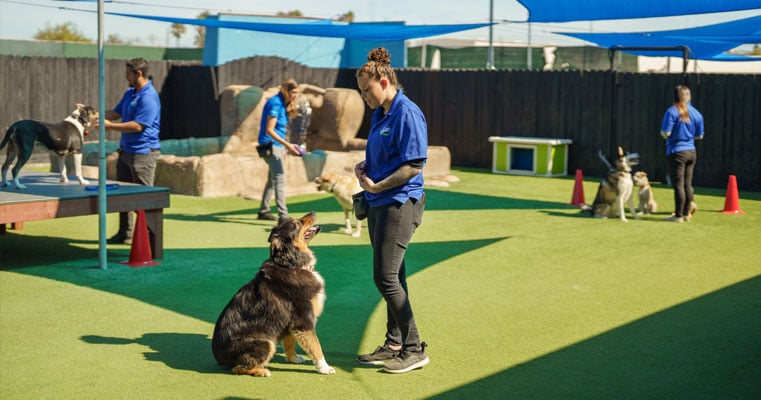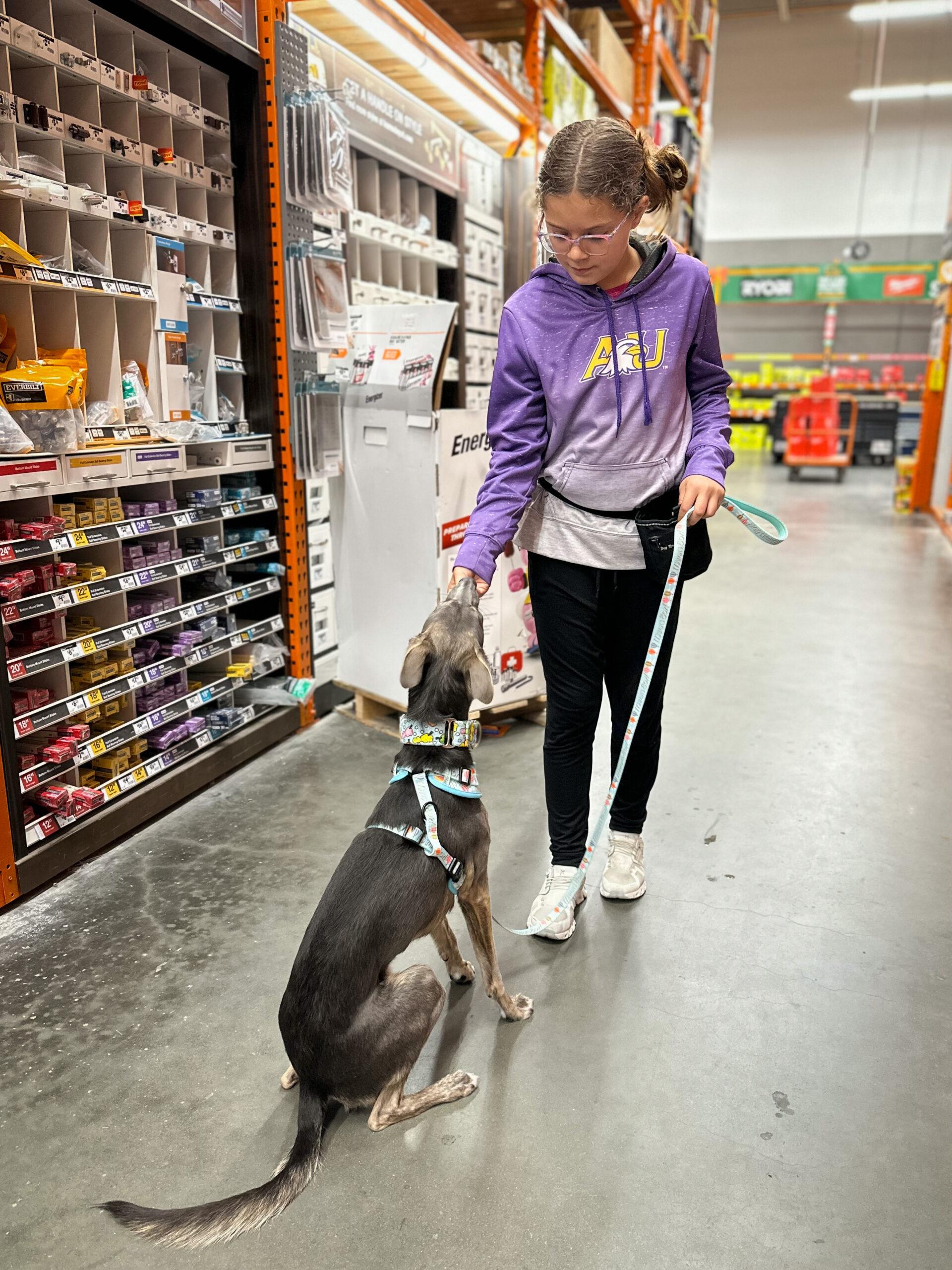Fun Tasks to Enhance Your Dog Training Experience
Fun Tasks to Enhance Your Dog Training Experience
Blog Article
Important Tips for Successful Dog Training: An Overview for Pet Dog Owners
Efficient canine training is a complex process that needs a tactical technique customized to both the family pet's character and the owner's purposes. Comprehending how to browse these challenges can substantially enhance the training experience, inevitably transforming the partnership in between owner and pet dog.
Understanding Canine Habits
Recognizing pet dog actions is necessary for reliable training and fostering an unified partnership in between dogs and their proprietors. dog training. Pet dogs communicate mainly with body language, articulations, and activities, making it critical for proprietors to analyze these signals accurately.

Socializing plays a considerable role in pet dog habits; exposure to various environments, individuals, and various other animals can significantly impact a dog's personality. Factors such as type features and private temperament need to guide training approaches, as some types may have particular behavior qualities that require tailored strategies. By comprehending these elements, proprietors can create an encouraging environment that motivates favorable actions, causing effective training outcomes and a deeper bond with their pets.
Establishing Consistent Commands
Efficient communication with your pet dog begins with developing consistent commands. This fundamental element of training is essential for cultivating understanding between you and your animal. Consistency in the commands you utilize ensures that your pet dog can reliably connect particular words or expressions with the desired habits.
When picking commands, choose clear, distinctive words that are simple to claim and distinguish from each other. Stay clear of utilizing similar-sounding commands that might perplex your dog. For example, utilizing "rest" and "remain" is appropriate, however "rest" and "hit" might bring about misunderstandings.
Additionally, preserve the exact same tone and quantity for each command. Pet dogs are delicate to singing signs, so varying your tone can create complication.
It is equally essential to ensure that all relative get on the very same page relating to the commands used. A united front in command use will avoid mixed signals and enhance the understanding procedure.
Positive Reinforcement Strategies
The power of positive reinforcement in canine training hinges on its ability to urge preferred behaviors via incentives and appreciation. This strategy is based in the principle that habits adhered to by desirable results are more most likely to be repeated. By integrating favorable reinforcement into your training routine, you can properly form your pet dog's behavior in a positive way.
To apply favorable support, it's necessary to recognize what motivates your pet, whether it be treats, playthings, or verbal appreciation. When your dog does a desired action, such as remaining on command, immediately award them with a treat or love. This association between the command and the positive result enhances their understanding.
It's critical to timing the incentives correctly; delivering the reinforcement within seconds of the desired actions assists your pet make the connection (dog training). Furthermore, uniformity is key-- make sure that all member of the family make use of the same commands and benefit systems to prevent confusion

Progressively, you can decrease the frequency of treats as your pet dog finds out the behavior, transitioning to applaud or periodic rewards. This method not only fosters a directory strong bond between you and your pet but likewise advertises a positive learning environment, making training a delightful experience for both.
Socialization and Communication
Regularly revealing your canine to a range of settings, individuals, and other pets is essential for their social growth. Socializing should start early, ideally throughout the critical home window of 3 to 14 weeks, when puppies are most responsive to brand-new experiences. Nonetheless, older pets can additionally take advantage of recurring socialization efforts.
Introduce your canine to different settings, such as parks, pet-friendly stores, and metropolitan areas. This direct exposure aids them adjust to different stimuli, minimizing stress and anxiety and anxiety feedbacks. Motivate positive interactions with various other canines and people, guaranteeing that these encounters are regulated and secure to cultivate self-confidence.
Utilize organized playdates with genteel canines, as this can enhance your pet dog's social skills and educate them ideal habits. Obedience courses and training sessions likewise provide exceptional possibilities for socializing, allowing your pet to communicate with others in a monitored environment.
Screen your pet's body language throughout communications, as this will aid you determine their convenience level. Slowly increase exposure to even more tough situations while guaranteeing that each experience declares. A well-socialized pet is more probable to display balanced actions, making them a delight to have in any type of setup.
Dealing With Usual Training Challenges
Every canine proprietor will run into training challenges at some time, no matter their dog's age or socialization level. Determining typical issues such as stubbornness, diversions, and terror can help in developing efficient approaches for improvement.

Progressively present disturbances as the pet dog ends up being more competent in commands. Short, frequent training sessions are also effective in keeping This Site focus.
Terror can prevent a pet's learning procedure. Steady desensitization to the resource of concern, combined with positive support, can help ease stress and anxiety. Persistence is critical; never ever compel a dog into a circumstance that triggers distress, as this might intensify the issue.
Inevitably, understanding and attending to these common challenges with a structured method will certainly promote a much more productive training experience, reinforcing the bond between canine and proprietor while promoting reliable understanding.
Final Thought
In recap, effective canine training relies upon a detailed understanding of canine behavior, the facility of consistent commands, and the application of positive reinforcement methods. Socialization plays an essential duty in developing well-adjusted pet dogs, while dealing with common training difficulties calls for patience and versatility. By implementing these essential strategies, animal owners can promote a solid bond with their canines and advertise desirable actions, ultimately causing an unified relationship in between human beings and their canine buddies.
Comprehending canine behavior is essential for efficient training and fostering an unified partnership in between canines and their owners.Socializing plays a significant duty in pet behavior; exposure to different settings, individuals, and other pets can significantly impact a pet dog's personality.The power of positive reinforcement in canine training exists in its capacity to urge desired actions with incentives and praise. By including positive reinforcement right into your training program, you can efficiently shape your canine's behavior in a useful way.
In recap, effective pet dog training depends on a thorough understanding of canine behavior, the their website establishment of constant commands, and the application of positive reinforcement techniques.
Report this page